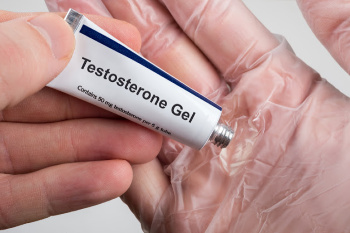Testosterone Patches and Gels Safer Than Injections, Study Says

Testosterone injections are associated with a higher risk of cardiovascular events when compared to patches and gels, according to a May report in JAMA Internal Medicine.
The hormone is important for men, as it drives many of their secondary sex characteristics, like facial hair, a deeper voice, and increased muscle mass. It’s also involved with a man’s libido.
Sometimes, men’s bodies can’t produce adequate amounts of testosterone on their own because of problems with their testes or pituitary gland. Testosterone replacement therapy can help restore hormonal levels.
==================================================
Testosterone patches and gels safer than injections, study says. (Click to tweet)
==================================================
Doctors may also prescribe testosterone to help with the normal hormonal declines that occur as men age. These decreases can cause low energy, depressed mood, and reduced sex drive.
There have been some concerns about the safety of testosterone therapy, however. Some studies have shown an increased risk of heart attack and stroke for men taking testosterone. Other researchers have found that this is not true.
A team of American and Swiss scientists wondered how the form of dosage – injection, gel, or patch – might play a role in this potential risk.
Testosterone injections, gels, and patches are three of the most common ways to take the hormone. Injections may be given in a doctor’s office or by the patient at home. Gels and patches may be applied directly to the skin, usually on the shoulder or upper arm.
The three methods provide sufficient amounts of testosterone. However, injections cause testosterone levels to spike and then gradually decrease. Gels and patches administer testosterone more evenly.
The researchers analyzed health records of 544,115 men in the United States and United Kingdom. All of the men had been on testosterone replacement therapy at some point. Approximately 37% used injections. Seven percent used patches and 56% used gels. Generally, the men were over 50 years old, although one group of U.S. Medicare recipients were in their 70s, on average. The men had not used testosterone for at least 180 days before the study began.
Next, the scientists looked at the men’s medical records for the next year to find out how frequently they had cardiovascular events, like heart attack or stroke. They also compared hospitalization and death rates by dosage type.
They found that the men who took testosterone by injection tended to have higher rates of such events, along with higher rates of hospitalization and death.
This does not mean that taking testosterone by injection causes these events. Also, the study had some limitations. For example, data on smoking status and body mass index were unavailable for some of the American men. These two factors can affect cardiovascular risk. And it was unclear whether the men were taking testosterone exactly as prescribed.
Still, the results could spur further research on the safety of testosterone. Investigating testosterone in longer-term studies could be helpful, the study authors explained.
Resources
JAMA Internal Medicine
Layton, J. Bradley, PhD, et al.
“Comparative Safety of Testosterone Dosage Forms”
(May 11, 2015)
http://archinte.jamanetwork.com/article.aspx?articleid=2293080
You may also be interested in...
Other Popular Articles

What Is the Average Penis Size?
If you have ever wondered how your penis compares to others in terms of size, you are not alone. Many men are curious to know how their penises stack up compared to the average. Unfortunately, general curiosity can sometimes give way to full-on obsession and anxiety about penis size. This can be an unhealthy and often unnecessary fixation, especially because most men who think their penises are too small have perfectly normal-sized penises.

What Is Jelqing, and Does It Actually Work?
The term “jelqing” refers to a set of penis stretching exercises that some believe can make the penis bigger. Although the practice has gained attention and popularity in blogs and internet forums in recent years, there is no scientific evidence that it is an effective way to permanently increase the size of one’s penis. In fact, in some cases, jelqing may actually cause damage to the penis, so it is a good idea to get all the facts before setting off to try it.

What Is Sensate Focus and How Does It Work?
Sensate focus is a technique used to improve intimacy and communication between partners around sex, reduce sexual performance anxiety, and shift away from ingrained, goal-oriented sexual patterns that may not be serving a couple.

Can Sex Reduce Menstrual Cramps?
The SMSNA periodically receives and publishes ‘guest editorials.’ The current article was submitted by Mia Barnes, a freelance writer and researcher who specializes in women's health, wellness, and healthy living. She is the Founder and Editor-in-Chief of Body+Mind Magazine.
Having sex while you experience menstrual cramps is healthy and can provide significant benefits. While it might not be the first activity that comes to mind when your PMS or period cramping begins, many people enjoy sex to reduce menstrual cramps, experience increased pleasure and benefit from other advantages. Learn more about having sex while menstrual cramps are happening and how it can help your body.

How Long Does It Take the Average Man to Ejaculate?
On average, it takes a man between 5 to 7 minutes to orgasm and ejaculate during sexual intercourse.

The Effect of Regular Aerobic Exercise on Erectile Function
Erectile dysfunction (ED) is the inability to achieve or maintain an erection sufficient for satisfactory sexual activity. As men get older, their erectile functioning may naturally decline due to changes in testosterone levels, cardiovascular functioning, and the potential development of other chronic medical conditions that become more common with age.
You are prohibited from using or uploading content you accessed through this website into external applications, bots, software, or websites, including those using artificial intelligence technologies and infrastructure, including deep learning, machine learning and large language models and generative AI.

